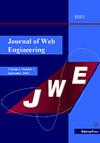Research on the Application of Graph Neural Networks Based on Multiple Attention Mechanisms in Personalized Recommendation
IF 1
4区 计算机科学
Q4 COMPUTER SCIENCE, SOFTWARE ENGINEERING
引用次数: 0
Abstract
Graph neural networks (GNNs) have been widely applied due to their ability to model interactions among different objects. However, from the perspective of mathematical graph theory, the existing GNN frameworks still face challenges when dealing with specific graph structure problems. Nevertheless, the existing graph neural networks are unable to accurately identify and capture user characteristics based on common interests, have difficulty in flexibly handling diverse user interests and the differences in interests among users, and cannot effectively extract and utilize the feature information of intermediate nodes. To address these issues, this paper proposes a heterogeneous graph recommendation model based on a multi-level attention mechanism (MAHGRM-HGNN). The MAHGRM model consists of three major modules: the node-level aggregation and feature fusion module, the semantic-level aggregation module, and the importance analysis module. By introducing dual attention mechanisms at the node level and semantic level, MAHGRM can effectively identify and fuse multi-hop neighbor information related to user interests, while modeling the semantic features represented by different paths. Additionally, MAHGRM adopts an innovative feature fusion method, integrating intermediate heterogeneous nodes and their related different paths according to the topological structure of the graph, thereby avoiding the loss of intermediate node information and enriching the feature representation of the target node. In the importance analysis module, MAHGRM introduces a strategy for evaluating the importance of product nodes by calculating the importance scores of different product nodes, selecting the most popular products as the candidate set, and randomly selecting some products from it for recommendation to users. MAHGRM combines the node-level aggregation and feature fusion, semantic-level aggregation, and importance analysis modules closely. The key advantage lies in its ability to effectively integrate multi-level information in heterogeneous graphs and the collaborative optimization effect brought by the cross-module feature sharing mechanism, making the final recommendation results more targeted and timely. This cross-module collaborative effect ensures the precise capture of user interests and the efficiency of product recommendations, preventing the repetition of recommending the same product to users. The experimental results were extensively tested on multiple real-world datasets. The results showed that the performance of MAHGRM was significantly superior to that of the comparison models such as GCN, GAT, HAN, HPN, OSGNN and ie-HGCN. On the MovieLens-1M dataset, the AUC, ACC and F1-score of MAHGRM reached 0.931, 0.867 and 0.863 respectively, achieving the best performance and fully demonstrating the superiority of MAHGRM in terms of performance.基于多注意机制的图神经网络在个性化推荐中的应用研究
图神经网络(gnn)由于能够对不同对象之间的相互作用进行建模而得到了广泛的应用。然而,从数学图论的角度来看,现有的GNN框架在处理具体的图结构问题时仍然面临挑战。然而,现有的图神经网络无法基于共同兴趣准确地识别和捕获用户特征,难以灵活处理用户不同的兴趣和用户之间的兴趣差异,无法有效地提取和利用中间节点的特征信息。为了解决这些问题,本文提出了一种基于多层次注意机制的异构图推荐模型(MAHGRM-HGNN)。MAHGRM模型包括三个主要模块:节点级聚合与特征融合模块、语义级聚合模块和重要性分析模块。MAHGRM通过引入节点级和语义级双重关注机制,有效识别和融合与用户兴趣相关的多跳邻居信息,同时对不同路径表示的语义特征进行建模。此外,MAHGRM采用了创新的特征融合方法,根据图的拓扑结构对中间异构节点及其相关的不同路径进行整合,避免了中间节点信息的丢失,丰富了目标节点的特征表示。在重要性分析模块中,MAHGRM引入了一种评估产品节点重要性的策略,通过计算不同产品节点的重要性分数,选择最受欢迎的产品作为候选集,并从中随机选择一些产品推荐给用户。MAHGRM将节点级聚合与特征融合、语义级聚合、重要性分析等模块紧密结合。其关键优势在于能够有效整合异构图中的多层次信息,以及跨模块特征共享机制带来的协同优化效果,使最终推荐结果更具针对性和及时性。这种跨模块的协同效应确保了对用户兴趣的精确捕捉和产品推荐的效率,避免了向用户重复推荐相同的产品。实验结果在多个真实数据集上进行了广泛的测试。结果表明,MAHGRM的性能明显优于GCN、GAT、HAN、HPN、OSGNN和ie-HGCN等比较模型。在MovieLens-1M数据集上,MAHGRM的AUC、ACC和f1得分分别达到了0.931、0.867和0.863,达到了最佳性能,充分体现了MAHGRM在性能上的优势。
本文章由计算机程序翻译,如有差异,请以英文原文为准。
求助全文
约1分钟内获得全文
求助全文
来源期刊

Journal of Web Engineering
工程技术-计算机:理论方法
CiteScore
1.80
自引率
12.50%
发文量
62
审稿时长
9 months
期刊介绍:
The World Wide Web and its associated technologies have become a major implementation and delivery platform for a large variety of applications, ranging from simple institutional information Web sites to sophisticated supply-chain management systems, financial applications, e-government, distance learning, and entertainment, among others. Such applications, in addition to their intrinsic functionality, also exhibit the more complex behavior of distributed applications.
 求助内容:
求助内容: 应助结果提醒方式:
应助结果提醒方式:


